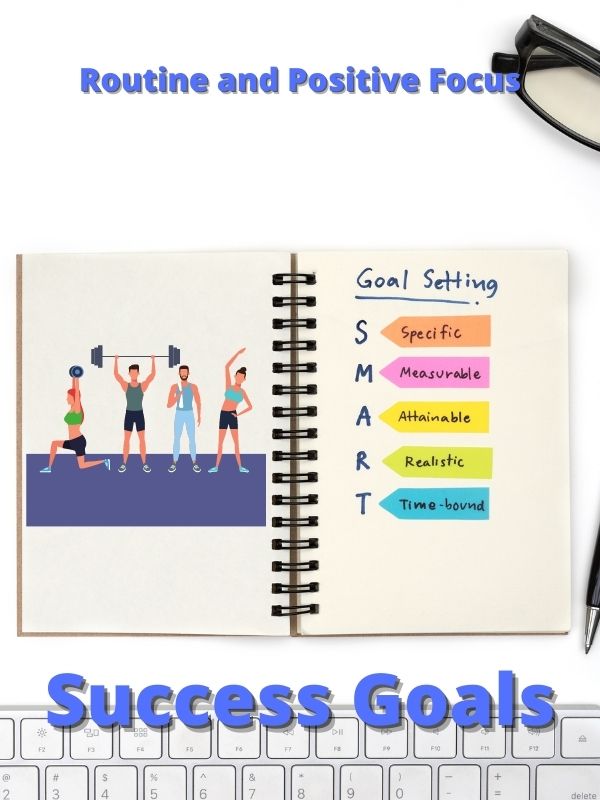I can be difficult to stick to an exercise routine. When your routine changes or life happens, you can get sidetracked. Setting exercise goals is important for me when I want to have realistic expectations of maintaining a consistent schedule.
To stay motivated all year long you’ll need to set realistic goals. The most important part of setting goals is to follow through on them. So, even if you only exercise for 1 minute, committing to exercise is what will ultimately keep you going all year long.
When I have been most successful with my exercise routine it’s because I have kept to a regular schedule and showed up to exercise. Establishing a routine was an important part of what kept me going all year long. Having realistic goals kept me from stopping exercise.
Brain Chemicals and Motivation

Whenever we pick up our cell phone to check the latest news, video, social post, we are getting a bit of dopamine. This release of dopamine helps motivate us to keep checking our phones or other devices.
In the same way, we get dopamine from our cell phones, we can get dopamine from setting and achieving goals. After you check that box off from your list of to-dos, the body’s natural response is to release dopamine as we feel we have accomplished a goal.
These boosts of dopamine may not be as frequent as from using a phone, but they help motivate us to keep working toward the goals we set.
Exercise is a good way to help us release dopamine, but it’s not always so obvious at first. Taking the time and committing to an exercise routine takes mental energy. We aren’t used to it and we naturally make feel resistance to change.
We may feel a strong sense that exercise is taking a lot of energy out of us. It’s natural to want to conserve energy, and it somewhat built into the biology of most animals. That’s why it’s important to feel good during exercise, so when we encounter resistance we can continue to stay with the goals we have set throughout the year.
Here are some ways to help balance the chemicals in your body to achieve an overall positive experience when exercising.
- Get Plenty of Sleep – While we can’t always control our sleep patterns, the better the quality of our sleep the less stress we will feel throughout the day. “Studies have shown that insomnia and other forms of sleep deprivation cause your body to secrete more cortisol during the day, perhaps in an effort to stimulate alertness.” (healthline.com)
- Drink Plenty of Water – we are always using water to aid in all the chemical reactions that are occurring in our bodies. Less water can lead to “stress and anxiety.” (primowater.com)
- Set Realistic Goals – The goals we set need to be ones we can achieve fairly easily on a consistent basis. Yes, it important to push yourself to achieve bigger goals, but not at first. Each time you achieve a goal, you usually get a boost of dopamine. This boost will give some motivation.
- Move for 10 Minutes or Move – Our bodies get chemical boosts from exercise if we can sustain our movement for ten minutes. This could be walking, running, biking, CrossFit, etc. As we move the body starts to release the chemicals “dopamine, norepinephrine, and serotonin” and our mood generally improves. (healthline.com)
- Socialize During Exercise – If you can find a friend to exercise with, it can help you release the chemical serotonin, the chemical that helps you feel at ease. The key is to bond with the person while exercising so you can have a closer relationship and feel connected. That way you can expect a serotonin release as you exercise and you’ll likely feel more committed to exercising with your friend.
- Think Positively About the Your Exercise Goals – Our thinking can help release dopamine as well. Even if we don’t see results from exercise, we can still motivate ourselves by thinking about working toward our goals and knowing we are on the right path. Then we tend to get a release of dopamine because we choose to focus on what’s going well.
If I can get more motivating chemicals released, I will be more likely to exercise the next day it is on my schedule. I have seen the positive effects of exercise on how I feel and the consistent release of feel-good chemicals as I am consistent with my exercise over the course of a year.
Setting Goals for Continued Success

How do you start an exercise routine that will last a year? It starts by making it a habit. You can make it a habit by being specific about the time and place we are going to exercise.
When I’m not used to something, I tend to be hit or miss about working towards a goal, unless I have written down a specific day and time I will work on it.
As we set exercise goals and accomplish them, there’s a release of dopamine is we focus on having accomplished the goal. It may not be as strong a feeling as we get from other activities, such as checking out a cell phone for a while, but it can start to motivate us toward our exercise goals.
That’s why it’s important to establish a routine so we can get into the habit of exercise even if we’re not motivated at the beginning.
In addition, it’s important to set smaller goals at first, that we can accomplish fairly easily. It important to try to focus positively on our accomplishments, even if it was easy. That way we start to be drawn toward exercise because we get a dopamine release as we feel good about achieving the goal.
Maintaining Your Exercise Routine

One factor that stops people from exercising is they lose motivation because of obstacles that get in the way. Sometimes these are mental obstacles, physical obstacles, emotional obstacles, and logistical obstacles.
In order to continue to exercise we need to remove the obstacles so have the ability to exercise without any restrictions. We can accomplish this by making changes to how we normally operate on a daily basis.
Here are some ways to overcome the obstacles that get in our way.
Mental Obstacles – Mental obstacles can have a wide range of ways they manifest. It can range from getting distracted often to not seeing how you can fit exercise into your schedule. You can remove mental obstacles by:
- Keeping an Exercise Journal – It helps you set goals and stay focused.
- Talk with Others – Talking can help you work out any concerns and help you feel more comfortable.
- Read an Inspirational Book – This can help you relate to others and motivate you to action.
Physical Obstacles – If you have an injury or a medical condition, it all of a sudden becomes really easy to stop exercising. When I am a little sick or have hurt my knee, it easy for me to make excuses not to exercise. The truth is I can still exercise, by doing one of the following:
- Learn New Exercises – New ways to exercise can give you the opportunity to exercise in order to avoid further injury.
- Enlist a Friend – Asking for help can help you get the support to exercise in a way you couldn’t without support. If you don’t ask, no one will help.
- Exercise Regularly – If you get slightly sick, it’s usually OK to do some exercise. This may vary greatly depending on your condition, so ask your doctor for advice regarding your specific condition. (Remember to avoid going to the gym or being around others when sick, and if you have a fever or are not generally not feeling well then it’s generally best not to exercise.)
Emotional Obstacles – If you are depressed or feel like you can make exercise a part of your life because of the negative feeling it evokes in you, then you might not want to exercise. Feelings of doubt, fear, irritation, or resentment can stop us from exercising. Here are some ways to help:
- Just Start – Most people who feel like they can’t exercise, often feel differently after starting to exercise for a few minutes. Those feelings start to change and they are actually glad they got out of the house or did some exercise at home.
- Talk it Out – Talking to someone for a while can change one’s mood from gloomy or angry to calm and capable.
- Let it Go – While emotional feelings aren’t easy to let go, at some point, we may start to recognize the harm that holding on to negative feelings is having on us.
- While once we felt trapped and alone, letting go of damaging negative emotions can help us feel freer and cared for (sometimes we need to be willing to ask for help). Then we have the strength to do some exercise and actually feel good about it.
Logistical Obstacles – For most people, if something changes from their regular routine they may decide they can’t exercise because it is outside of their comfort zone. They may not see any time slots available.
- Change Your Schedule – Making a change to your normal routine is difficult for most. You’ll need to try your best to stick with the new schedule for about a month for it to start to feel normal. If you’re successful you’ll have established a routine that makes time for exercise instead of trying to fit it in.
- MicroDose – If you feel that changing your schedule is too challenging, try setting an alarm during the day, to stop everything and exercise for a few minutes. This might be during lunch or several times during the workday, helping break up the daily monotony.
- Workout During Work – You’ve got too much on your plate and once the day is done you head right to bed. If this is you, try integrating exercise into your workday. Some people have a stand-up desk, an exercise peddler, or use weights as the work during the day.
Once you have made an effort to tackle the obstacles that are in your way you will find it easier to exercise more regularly.
I know for me it took a change in attitude about what my overall goal was during exercise. I finally found that the best way for me to exercise regularly was to just get dressed and start. I had no expectation of what the outcome should be.
This motivated me to exercise much more because I didn’t have to live up to my unreal expectations. I still had an exercise routine, but if I wasn’t motivated during exercise I could stop at any time.
Sometimes I was tired, sick, inquired, or sad. Yet, I still went to exercise but gave myself a pass on exercising the full time or the full routine.
Everyone is different, so you’ll need to find what works best for you.
Final Thoughts
You can definitely find ways to motivate yourself to exercise that are healthy and help you establish a routine that lasts throughout the year. Remember that your expectation of what should happen can be adjusted to a more realistic program that works to keep you going.
Use your brain chemical to help motivate you toward your goals. Exercise should be more of an expression of your energy rather than necessary labor to perform. Do what you can to enjoy it.
Last, take time to write down your general goals and routine schedule. Then you can work on modifying your goals and schedule to be meet your need to feel motivational on a regular basis.
If you liked this article please visit some of the other articles on this site.
Thanks for visiting Helpshoe.com
References
https://pubmed.ncbi.nlm.nih.gov/25905298/
https://www.healthline.com/health/cortisol-and-sleep#how-it-affects-sleep

